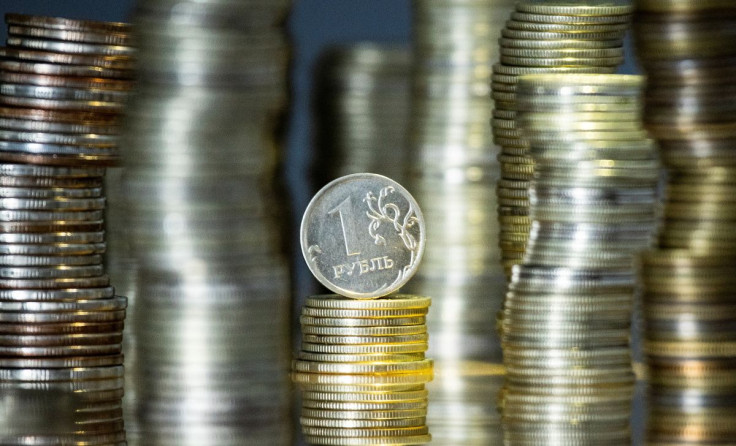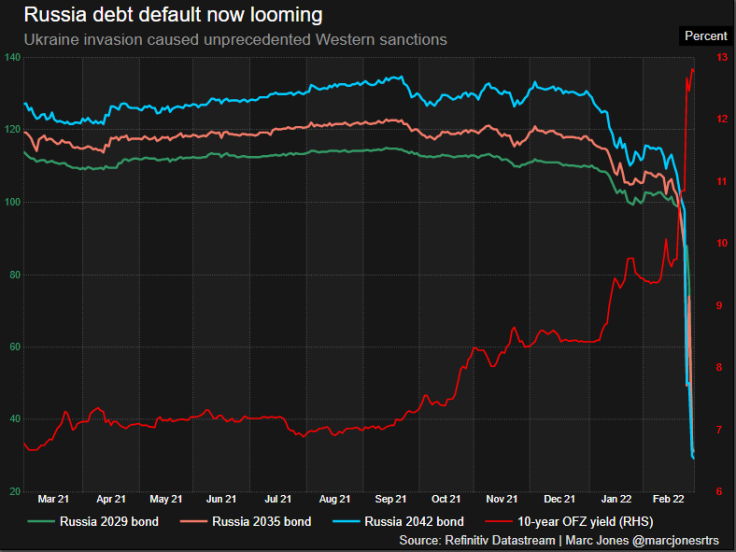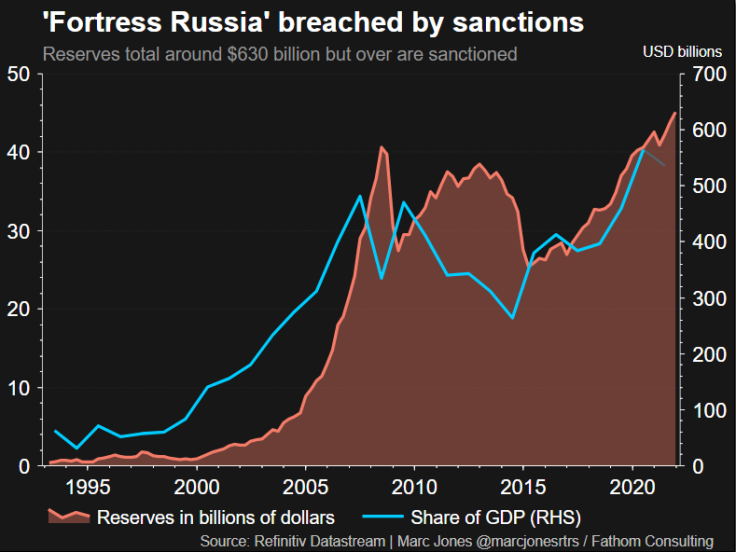Sanctions-savaged Russia Teeters On Brink Of Historic Default

The economic cost of Russia's assault on Ukraine was fully exposed on Wednesday as Vladimir Putin's sanctions-ravaged government teetered on the brink of its first international debt default since the Bolshevik revolution.
Moscow was due to pay $117 million in interest on two dollar-denominated sovereign bonds it had sold back in 2013. But the limits it now faces making payments, and talk from the Kremlin that it might pay in roubles - triggering a default anyway - meant even veteran investors were left guessing at what might happen.
One described it as the most closely watched government debt payment since Greece's default at the height of the euro zone crisis. Others said an emergency 'grace period' that allows Russia another 30 days to make the payment could drag the saga out.
"The thing about defaults is that they are never clear cut and this is no exception," said Pictet emerging market portfolio manager Guido Chamorro.
"There is a grace period, so we are not really going to know whether this is a default or not until April 15," he said referring to the situation if no coupon payment is made. "Anything could happen in the grace period."
A Russian government debt default was unthinkable until what Putin called a "special military operation" in Ukraine began in late February.
It had nearly $650 billion of currency reserves, coveted investment-grade credit ratings with S&P Global, Moody's and Fitch, and was raking in hundreds of millions of dollars a day selling its oil and gas at soaring prices.
Then the tanks rolled and the United States, Europe and their Western allies fired back with unprecedented sanctions, which froze two-thirds of Russia's reserves that it turned out were held overseas.
"I think the market now expects Russia not to make the (bond) payments," the head of emerging market debt at Aegon Asset Management Jeff Grills, adding the conflict was one of the few emerging market events capable of really unsettling global markets.
That is because Russia's role as one of the world's top commodity producers has sent prices and global inflation skywards.
At the same time it has left Russia a virtual pariah state, crippled by sanctions and watching hundreds of the world's largest firms now quit the country after deciding their presence there is no longer feasible.
(Graphic: Russia international debt default looming,

)
DEFAULT SCENARIOS
As for Russia's battered government bonds, most are now changing hands at just 10%-20% of their face value.
The two payments on Wednesday are the first of several, with another $615 million due over the rest of March, and the first 'principal' - final full payment of a bond - on April 4 worth $2 billion alone.
Experienced investors see three potential scenarios for how Wednesday's crucial deadline plays out.
The first is that Moscow pays in full and in dollars, meaning default worries go away for the time being.
Big Russian energy providers Gazprom and Rosneft have both made payments on international bonds over the last 10 days so there is still a sliver of hope it could be done if Moscow feels it is in its interests.
The second possibility is that Moscow doesn't pay, starting the 30-day grace period countdown clock until default.
A third option where Russia pays but in roubles is also possible, although the legal terms of the bonds would mean that is still tantamount to a default. The 30-day grace rule would still apply.
"Maybe we will know today (if they pay) but maybe we won't," said Pictet's Chamorro. His firm doesn't hold the bonds, but does hold other Russian bond - and when a country defaults on one of its bonds it tends to mean all its bonds 'cross default'.
"In situations like these it's safest to expect the unexpected. You can't really rule anything out".
(Graphic: Fortress Russia crumbled under sanctions,

)
© Copyright Thomson Reuters 2024. All rights reserved.



















